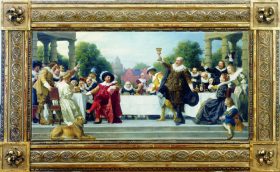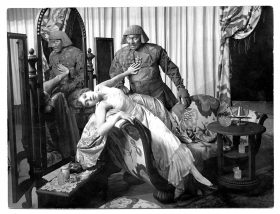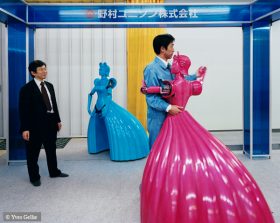– The Story of a Search

This oil sketch entitled Das Gastmahl der Familie Mosse (The Mosse Family Banquet) was restituted to the community of heirs of Felicia Lachmann-Mosse; Photo: Jewish Museum Berlin, Jens Ziehe.
Today is the International Holocaust Remembrance Day when we also remember the consequences of the criminal Nazi regime, which can still be felt today. One of these consequences is that a lot of museums are still holding cultural artifacts that were unlawfully confiscated from their owners during the Nazi era. Thus the Jewish Museum Berlin restored the oil sketch Das Gastmahl der Familie Mosse (The Mosse Family Banquet) to the heirs of Felicia Lachmann-Mosse in December last year. How was this decision reached? Provenance research has attracted increasing attention in recent years and caused frequent rumblings in the media – but how is it actually carried out? → continue reading

In the light comedy The Golem and the Dancing Girl from 1917, Paul Wegener satirizes his own 1915 film The Golem; photo: Deutsches Filminstitut, Frankfurt a. M./estate Paul Wegener – collection Kai Möller
In January of 1915 the figure of a golem appeared for the first time on the silver screen, on Berlin’s Kurfürstendamm. The public was captivated by a truly modern monster. At the same time, southeast of the Belgian city of Ypres battles of the First World War were raging. Following on the heels of this first silent golem movie came two more in 1917 and 1920, also debuting in Berlin. The lead role of the golem was played in all of them by Paul Wegener, who had also come up with the idea for the projects and written the screenplays.
In the current exhibition GOLEM (more on www.jmberlin.de/en/golem), a theme room has been dedicated to these three silent movies. → continue reading
The golem, a character from Jewish mythology, is currently present in an interesting exhibition at the Jewish Museum Berlin. But not only there.

Yves Gellie, Human Version 2.08, Dancing Robot, Tohoku University, Japan; photo: Yves Gellie, galerie du jour agnès b
Guest article by Roberto Giardina, www.ildeutschitalia.com
In the foyer of the Museum for Communication, three robots – reminiscent of chess figures – are roaming around. They talk to the people walking up to them, stop and take a different route if you block their way, or accompany you when you walk next to them. Adults are just as fascinated as children. A visit to Berlin museums is fun, and doesn’t necessarily require you to speak German.
After playing on the ground floor at the Museum for Communication, you can visit the special exhibition on the Golden Section and have your forgotten school knowledge entertainingly refreshed (the exhibition Göttlich Golden Genial (godly golden genius) runs until 26 February, more on the Museum for Communication website (in German)).
Robots are fun to play with, but they have been the stuff of nightmares since time immemorial – will they take our jobs away from us soon? → continue reading


